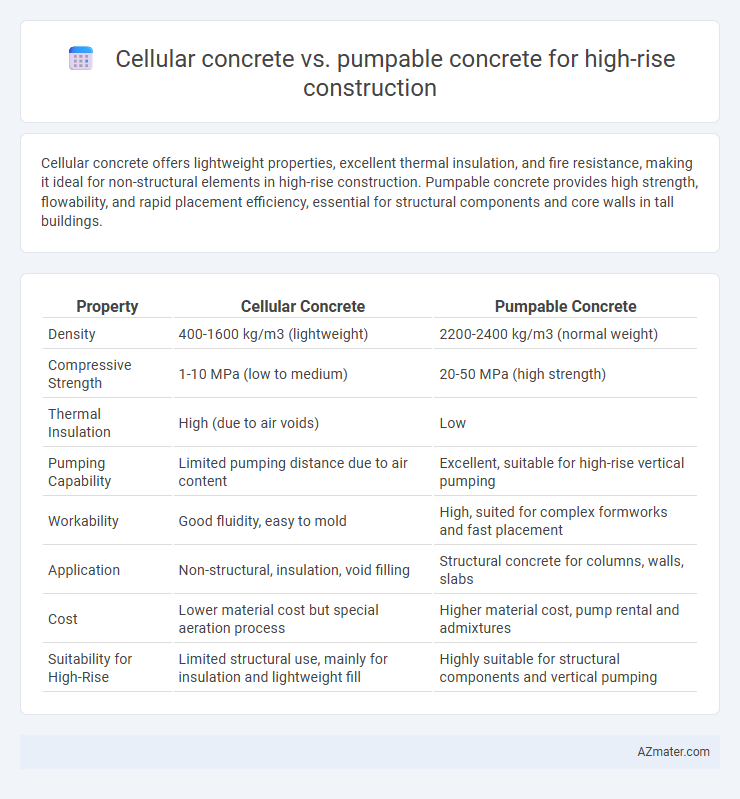Cellular concrete offers lightweight properties, excellent thermal insulation, and fire resistance, making it ideal for non-structural elements in high-rise construction. Pumpable concrete provides high strength, flowability, and rapid placement efficiency, essential for structural components and core walls in tall buildings.
Table of Comparison
| Property | Cellular Concrete | Pumpable Concrete |
|---|---|---|
| Density | 400-1600 kg/m3 (lightweight) | 2200-2400 kg/m3 (normal weight) |
| Compressive Strength | 1-10 MPa (low to medium) | 20-50 MPa (high strength) |
| Thermal Insulation | High (due to air voids) | Low |
| Pumping Capability | Limited pumping distance due to air content | Excellent, suitable for high-rise vertical pumping |
| Workability | Good fluidity, easy to mold | High, suited for complex formworks and fast placement |
| Application | Non-structural, insulation, void filling | Structural concrete for columns, walls, slabs |
| Cost | Lower material cost but special aeration process | Higher material cost, pump rental and admixtures |
| Suitability for High-Rise | Limited structural use, mainly for insulation and lightweight fill | Highly suitable for structural components and vertical pumping |
Introduction to Cellular and Pumpable Concrete
Cellular concrete is a lightweight, aerated material composed of cement, water, and pre-formed foam, offering excellent thermal insulation and reduced structural loads in high-rise construction. Pumpable concrete, formulated with a mix of fine aggregates and admixtures, ensures high fluidity and strength, enabling efficient placement in tall structures through pumping equipment. Both materials enhance construction speed and quality, with cellular concrete focusing on insulation and light weight, while pumpable concrete emphasizes flowability and structural integrity.
Composition and Material Properties
Cellular concrete contains lightweight cementitious foam mixed with water and cement, resulting in a highly insulating material with low density and excellent fire resistance, ideal for reducing structural loads in high-rise construction. Pumpable concrete, composed of cement, aggregates, water, and admixtures, features high flowability and workability, ensuring efficient placement and consolidation in complex vertical pours. The material properties of cellular concrete emphasize thermal insulation and reduced weight, while pumpable concrete prioritizes flow characteristics and strength development for load-bearing applications.
Workability and Flow Characteristics
Cellular concrete offers superior workability due to its lightweight structure and high air content, enabling easier placement and reduced pumping pressures in high-rise construction. Pumpable concrete features optimized flow characteristics with enhanced viscosity and cohesion, ensuring smooth transportation through long vertical pipelines without segregation. Both materials improve efficiency, but cellular concrete excels in reducing weight load, while pumpable concrete provides consistent flow crucial for continuous vertical pumping.
Strength and Load-Bearing Capacity
Cellular concrete offers lower density and superior thermal insulation but typically exhibits reduced compressive strength compared to pumpable concrete, limiting its load-bearing capacity in high-rise construction. Pumpable concrete, designed for enhanced strength and flowability, provides higher compressive strength and improved structural integrity essential for supporting vertical loads in tall buildings. Engineers prioritize pumpable concrete for core structural elements requiring maximum load-bearing capacity, while cellular concrete is often reserved for non-load-bearing partitions or insulation layers.
Weight and Density Comparison
Cellular concrete typically has a density range of 400 to 1600 kg/m3, making it significantly lighter than pumpable concrete, which usually ranges from 2200 to 2500 kg/m3. The reduced weight of cellular concrete decreases the dead load on structural elements, enhancing design efficiency for high-rise buildings. Pumpable concrete's higher density offers greater compressive strength but adds substantial weight, impacting overall structural load and foundation requirements.
Thermal and Acoustic Insulation
Cellular concrete offers superior thermal insulation due to its lightweight, porous structure that traps air, significantly reducing heat transfer in high-rise construction. Pumpable concrete provides adequate acoustic insulation but lacks the enhanced thermal resistance found in cellular concrete, making it less effective for energy-efficient buildings. High-rise projects requiring optimized energy performance and noise control often benefit more from cellular concrete's combined insulating properties.
Pumping and Placement Techniques
Pumpable concrete for high-rise construction utilizes advanced pumping techniques such as vertical and horizontal lines with pressures up to 100 bar, enabling efficient placement at great heights. Cellular concrete offers lighter weight and lower density but requires specialized pumps to manage its air-entrained mix, often limiting pumping distance and height. Optimizing mix design with appropriate admixtures like superplasticizers and stabilizers enhances flowability and stability, critical for consistent placement during high-rise applications.
Cost Analysis and Economic Considerations
Cellular concrete offers significant cost savings in high-rise construction due to its lightweight properties, reducing structural load and foundation expenses compared to pumpable concrete. Pumpable concrete, while offering high strength and rapid placement, incurs higher costs related to admixtures and specialized pumping equipment. Economic considerations favor cellular concrete in projects prioritizing thermal insulation and soundproofing, whereas pumpable concrete is advantageous when structural performance and efficient vertical transportation are critical.
Sustainability and Environmental Impact
Cellular concrete offers enhanced sustainability in high-rise construction due to its lightweight properties, which reduce structural load and decrease the demand for raw materials and transportation energy compared to traditional pumpable concrete. Its insulating characteristics improve energy efficiency in buildings, lowering long-term environmental impact through reduced heating and cooling requirements. Conversely, pumpable concrete, while durable and versatile, typically involves higher carbon emissions during production and lacks the intrinsic thermal benefits of cellular concrete, making it less eco-friendly for sustainable high-rise projects.
Best Applications for High-Rise Construction
Cellular concrete offers excellent thermal insulation and lightweight properties ideal for high-rise buildings aiming to reduce structural load and improve energy efficiency. Pumpable concrete, known for its high flowability and strength, is preferred for fast vertical placement in complex high-rise construction projects requiring durable and uniform structural elements. Selecting between these materials depends on balancing structural requirements, energy performance goals, and construction speed in high-rise applications.

Infographic: Cellular concrete vs Pumpable concrete for High-rise construction
 azmater.com
azmater.com